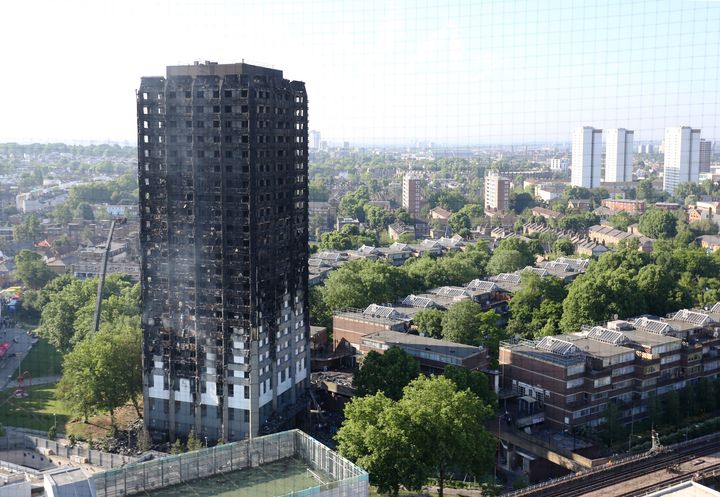Lives were lost in Grenfell Tower because controversial “stay put” advice was not revoked earlier but flammable cladding was the “principal” reason behind the catastrophic fire’s rapid spread, the official inquiry has found.
Judge Sir Martin Moore-Bick, who leads the inquiry, has called on Prime Minister Boris Johnson to back 46 changes to laws and regulations to ensure the safety of high-rise residents.
The retired judge also hit out at the London Fire Brigade’s “gravely inadequate” preparation for such a disaster, adding that having no strategy to evacuate the tower was a “major omission”.
But he made clear that man who lived in the flat where the fire started, Behailu Kebede, was not to blame.
Survivors had previously urged chairman Sir Martin Moore-Bick to formally exonerate Kebede, who was offered police protection after false reports of his culpability circulated online.
The retired judge said the resident, who lived in flat 16, bore no blame for the fire, which he found started in a faulty fridge-freezer in his home.
Moore-Bick also said in a statement on Wednesday that he paid tribute to the “courage and devotion” of firefighters who “repeatedly entered the building to rescue occupants at great risk to themselves”.
But he went on to criticise the fire service’s response and said call handlers were overwhelmed and failed to provide proper fire safety guidance.
“Those who were liable to be called upon to act as incident commanders were not trained to recognise a fire in the external wall of a high-rise building, nor were they trained in how to respond to it,” he said.
“There was no contingency plan for evacuation of the tower and the LFB failed to revoke the ‘stay put’ advice at a time when the stairs remained passable.
“Had it done so, more lives could have been saved. There was a lack of effective communication between the control room and the incident commander, resulting in a failure to share important information.
“There were serious deficiencies in command and control and many of the communications systems did not work properly.”
He added the refurbishment, which included adding the combustible cladding did not comply with building regulations as they did not adequately resist the spread of the fire. “On the contrary, they promoted it,” he said.
The second phase of the public inquiry must focus on who is to blame for the “devastating refurbishment” of the building, Justice 4 Grenfell has said.
The campaign group, who point out residents repeatedly warned of fire risks, said firefighters “have been made scapegoats of Phase 1 [of the inquiry] while the ‘big’ players seem to have got off scot-free”.
Prime Minister Boris Johnson said he hoped the report would bring “some measure of comfort” to those directly affected by the fire.
He said: “They asked for the truth. We promised them the truth. We owe them the truth.
“And, today, the whole country, the whole world, is finally hearing the truth about what happened at Grenfell Tower on the 14th of June 2017.
“For the survivors, the bereaved, and the local community, this report will prove particularly harrowing.
“Yet I hope it strengthens their faith in the inquiry’s desire to determine the facts of the fire – and in this government’s commitment to airing those facts in public, no matter how difficult they may be, and acting on them.
“That commitment is absolute.”
The disaster in June 2017 claimed the lives of 72 people.
Recommendations in the Phase 1 report

Evacuation:
– the government must develop national guidelines for carrying out partial or total evacuations of high-rise residential buildings, which include procedures for evacuating people who are unable to use the stairs in an emergency, or who may require assistance (eg disabled people, older people and young children)
– fire and rescue services must develop policies and training for partial and total evacuation of high-rise residential buildings
– all current and future high-rise residential buildings must be equipped with sounders or similar devices enabling fire services to send an evacuation signal to the whole or a selected part of the building
– all fire and rescue services must be equipped with smoke hoods for evacuation through smoke-filled exit routes
The owner and manager of every high-rise residential building must:
– draw up and regularly review evacuation plans, provide copies in electronic and paper form to their local fire service and place in an information box on the premises
– prepare personal emergency evacuation plans (PEEPs) for all residents whose ability to self-evacuate may be compromised and keep these in the information box
– the owner and manager of every residential building containing separate dwellings must provide fire safety and evacuation instructions in a form that the occupants of the building can reasonably be expected to understand
Emergency calls:
– The LFB’s policies must be amended to draw a clearer distinction between callers seeking advice and callers who believe they are trapped and need rescuing
– all fire and rescue services must develop policies for handling a large number of fire survival guidance (FSG) calls simultaneously
– electronic systems must be developed to record FSG information in the control room and display it simultaneously in units at the fire
– policies must be developed for managing a transition from “stay put” to “get out”
– control room staff must receive training on handling such a change of advice and conveying it effectively to callers
Fire doors:
– they must carry out checks no less than every three months to ensure that all fire doors are fitted with effective self-closing devices in working order
– all those who have responsibility for the condition of the entrance doors to individual flats in high-rise residential buildings with unsafe cladding must ensure that they comply with current standards
Floor numbers:
– floor numbers must be clearly marked on each landing within the stairways and prominently in all lobbies so they are visible both in normal conditions, low lighting and smoke
Plans and inspections:
The owner and manager of every high-rise residential building must:
– provide their local fire service with information about the design and materials of its external walls and inform them of any material changes
– provide their fire service with up-to-date paper and electronic floor plans, showing key fire safety systems
– regularly inspect lifts intended to be used by firefighters in an emergency, test the mechanism which allows firefighters to take control of them and report the results to the fire service every month
All fire and rescue services must:
– ensure that all officers of the rank of crew manager and above are trained and aware of the requirements expected during inspections of high-rise buildings
– be equipped to receive and store electronic plans and to make them available to incident commanders and control room managers
– ensure that all staff understand the risk of fire taking hold in the external walls and know how to recognise this
Communication:
– all officers who may be expected to act as incident commanders must receive training on communication with the control room
– all control room operators of assistant operations manager rank and above must receive training on communication with the incident commander
– a dedicated communication link must be provided between the senior officer in the control room and the incident commander
Command and control:
– the LFB must develop policies and training to ensure better control of deployments and the use of resources
– the LFB must develop policies and training to ensure that better information is obtained from crews returning from deployments and that it can be made available immediately to the incident commander
– the LFB must develop a communication system to enable direct communication between the control room and the incident commander and improve the means of communication between the incident commander and the bridgehead
– the LFB must investigate the use of modern communication techniques to provide a direct line of communication between the control room and the bridgehead
Equipment:
– the LFB must urgently take steps to obtain equipment that enables firefighters wearing helmets and breathing apparatus to communicate with the bridgehead effectively
– the LFB must urgently take steps to ensure that the command support system is fully operative on all command units and that crews are trained in its use
Emergency services:
– each emergency service must communicate the declaration of a major incident to each other as soon as possible
– clear lines of communication must be established as soon as possible between the control rooms of the individual emergency services
– steps must be taken to investigate the compatibility of the emergency services’ systems with a view to enabling them to read each others’ messages
– Emergency services and local authorities must investigate ways of improving the collection of information about survivors and making it available more rapidly to those wishing to make contact with them
Investigations in Phase 2 report
The judge has set out a number of areas for investigation in the Phase 2 report. They include:
Wider failings by the London Fire Brigade
Moore-Bick has said he plans to further investigate what he calls “far-reaching questions about the LFB as an organisation” whose performance “fell below standards set by its own policies or national guidance”.
The LFB failed to learn the lessons of the catastrophic Lakanal House fire and there was a “failure to understand the risk of cladding fires in high-rise buildings” and a “significant divergence between policy and practice” in a number of areas.
Testing of combustible materials
The current regime for testing the safety of cladding or other building materials “may be neither rigorous nor as effectively enforced as it should be”, according to Moore-Bick.
“Grave concern inevitably arises from the fact that it was possible for highly combustible materials to be used for the purposes of refurbishing and cladding a building like Grenfell Tower,” he said.
Questions will be asked of regulators and the construction industry, he said, adding it would be “sensible” for anyone responsible for fire safety in high-rises to “scrutinise the information” provided by manufacturers and “exercise considerable care to ensure that they meet the required standards”.
The ignored warnings about fire safety
In the phase two report, the judge will investigate further whether Kensington and Chelsea council and the tenant management organisation failed to heed repeated warnings from residents that the building was unsafe.
“There is a strong feeling among them that their voices were ignored and that if attention had been paid to them the disaster could have been avoided. There is also a strong view in many quarters that in their response to the disaster the authorities failed the community by not providing adequate support in the days immediately following the fire.”

